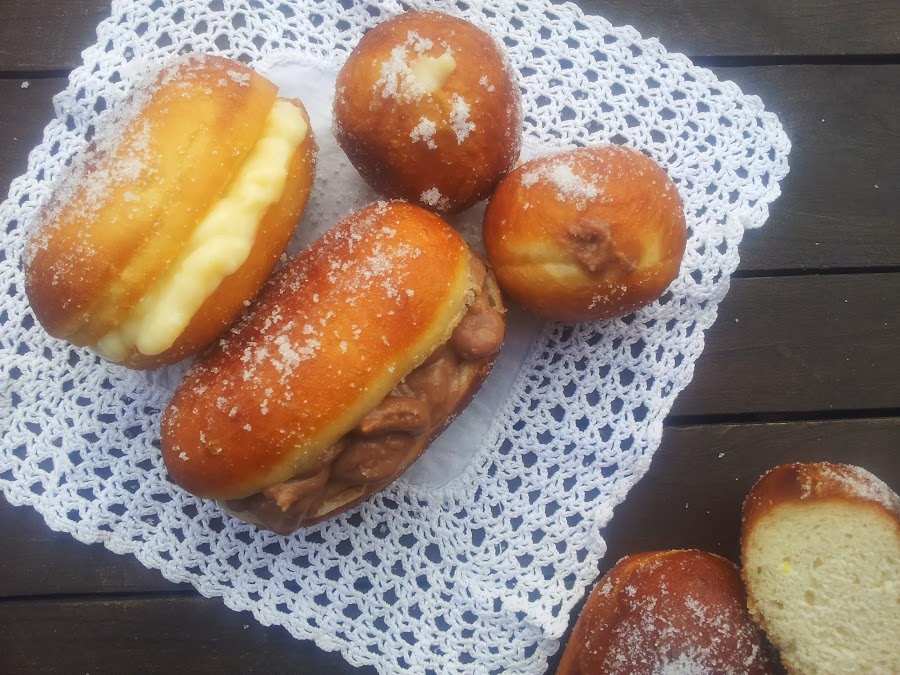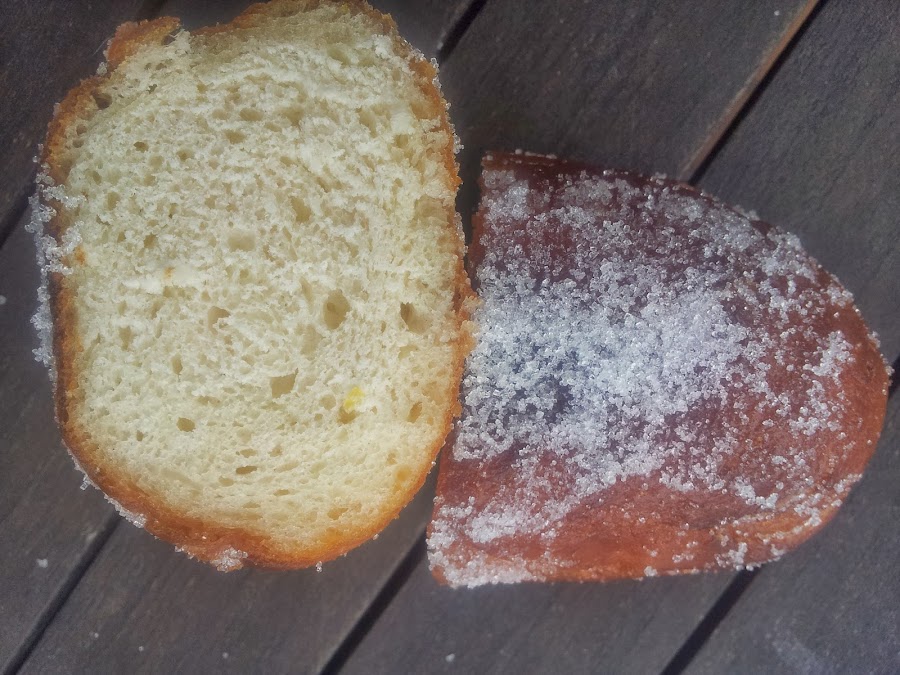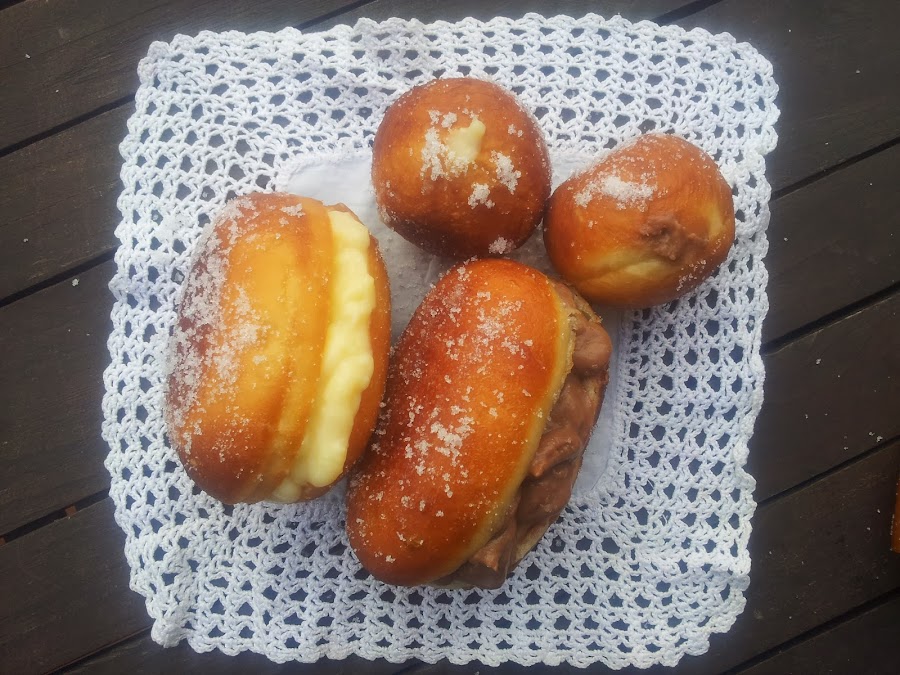Para la masa madre:
1/4 kg. de harina de fuerza
15 g. de levadura fresca, o de panadero, o prensada
150 g. de agua del grifo
Para la masa:
1/2 kg. de harina de fuerza o fuerte
1-2 huevos, alrededor de 75-80 g. de huevo sin cáscara
100 g. de azúcar
125 g. de mantequilla
15 g. de sal
150-250 g. de agua
la ralladura de medio limón
100 ml. de leche
Para la crema pastelera de vainilla:
1 l. de leche
200 g. de azúcar
4 yemas
2 huevos enteros
70 g. de maicena
la cáscara de un limón
1 vaina de vainilla
Para la crema pastelera de cacao amargo:
los mismos ingredientes que para la de vainilla pero sólo añadiremos media vaina y
50-75 g. de cacao en polvo sin azúcar
Elaboración de la masa madre:
Ponemos agua templada, máximo a temperatura corporal, en un recipiente grande.
Amasamos los tres ingredientes, con la harina tamizada, de la masa madre, lo justo para que se unan y podamos hacer una bola. La metemos en el agua. Al principio se hundirá y sabremos que está fermentada cuando suba a la superficie, alrededor de quince minutos después, pero depende de la temperatura del agua.
Elaboración de la masa de bollería:
Hacemos un volcán con la harina tamizada, y en el hueco del volcán añadimos todos los ingredientes, con la mantequilla a temperatura ambiente, pero no derretida. Todos los ingredientes deberían tener más o menos la misma temperatura, de esta forma trabajamos mejor. Para que no se desmorone por toda la encimera o mesa de trabajo, os recomiendo que vayáis incorporando, con los dedos de una mano, los ingredientes desde el interior hacia los bordes del cráter, e ir incorporando la harina poco a poco. De esta forma el proceso es más manejable, no se desmorona y conseguimos controlar la masa perfectamente. Cuando hayamos unido los ingredientes y antes de empezar a amasar, incorporamos la masa madre, que sacaremos con una mano, y sin apretar, simplemente dejando que el agua caiga, y empezamos a amasar.
Este es el proceso más largo y delicado, debemos conseguir una masa fina y algo brillante, con elasticidad. Para garantizarnos un buen amasado, os recomiendo que al menos lo hagáis durante 10 minutos a mano y 5 con algún tipo de amasadora, que no dé calor a la masa. Si os apetece os dejo el link de mi tutorial sobre técnicas básicas de amasado.
Una vez terminado el amasado, boleamos, es decir hacemos una bola con los cantos de las manos, a la vez que damos vueltas a la masa y cerramos el "culo". La colocamos con el culo hacia abajo en un bol o recipiente grande espolvoreado de harina y lo tapamos con un paño. Debemos dejar que fermente en un lugar cálido y sin corrientes, yo os recomiendo el horno, hasta que doble de volúmen. No os digo un tiempo exacto porque depende de la temperatura, no es lo mismo en invierno que en verano, etc.
Una vez que tengamos la masa fermentada, espolvoreamos la superficie de trabajo y la colocamos encima. Debemos quitar el aire y cortarla con cuchillo afilado de unos 20-30 g. por pieza, para las berlinas, y de 40-50 g. para los pepitos fritos. Os aconsejo que peséis cada pieza, quedan mucho más bonitas y a la hora de freirlas es más fácil que sean todas iguales, por lo menos de tamaño. Las volvemos a bolear, una por una, dándoles después forma alargada a los pepitos, y las vamos colocando en una fuente de horno con papel sulfurizado para la tercera fermentación (la primera fue la de la masa madre). Tapamos con un pañito limpo y volvemos a dejar fermentar hasta que doblen su volúmen, en sitio templado y sin corrientes.
Preparamos aceite en una sartén grande, si es de oliva que no sea muy intenso, pero os recomiendo de girasol para que no modifique mucho el sabor de la masa. Lo calentamos con la corteza de un limón, sólo la parte más y después la retiramos para que no se queme y empezamos a freir nuestra bollería. Este pequeño truco se hace también con pan, y sirve para quitarle fuerza al aceite, aunque ahora lo tenemos muy refinado le da un sabor muy rico. Dejar que doren y darles la vuelta. Sacar sobre papel de cocina para eleminar bien el exceso de aceite. Dejar enfriar totalmente.
Elaboración de las cremas:
Calentamos la leche con los aromas elegidos, que en este caso son la cáscara de limón y la vainilla, que abriremos longitudinalmente para sacarle todas las semillas que añadiremos a la leche junto con la propia vaina. En el caso del cacao con media vaina, sin semillas es suficiente. Cuando de un hervor lo tapamos para que adquiera bien los aromas, es decir infusione, y además para que pierda un poco de temperatura.
Aparte mezclamos el resto de los ingredientes con una varilla, pero simplemente los unimos porque cuanto más batamos más blanquecinas quedarán las yemas y los huevos y más clara por tanto nuestra crema.
Colamos la leche y la echamos de una sola vez, moviendo rápidamente la varilla, sobre la mezcla de huevos, para que no cuaje. Y volvemos a colar para quitar los posibles grumitos que se hayan podido formar. No tengáis miedo, volcar la leche de una vez, sin dejar de mover con la otra mano la varilla, porque si lo hacéis poco a poco la zona del huevo que entra en contacto con la leche caliente se va cortando, es mejor de esta forma, sin miedo.
Volver a colocar sobre el fuego para que dé un hervor, sin dejar de remover porque se pega rápidamente y dejar enfriar totalmente.
Para la de cacao se lo añadiremos justo en esta parte final, removiendo bien, mejor tamizado para que no forme grumos.
Terminación de las berlinas y pepitos:
Cuando la masa frita esté totalmente fria la rellenaremos con manga y boquilla especial para rellenar, que es fina y con la boca más alargada para que la podamos introducir perfectamente hasta el interior de la masa. También podemos cortar las piezas a la mitad y rellenar con boquilla lisa y manga pastelera.
Pasar después por azúcar en grano.
Nota: Esta masa aguanta en muy buenas condiciones dos días, a partir de entonces pierde muchas cualidades, pero por supuesto sigue estando muy rica. Al tener crema debe guardarse en frío, muy protegida con film, o en una cajita muy hermética, porque de otra forma se podría estropear rápidamente.
Os aconsejo que la comáis el mismo día, es una verdadera delicia.
Otra nota: Esta masa de bollería sirve perfectamente para los donuts
Y otra más: También os dejo el link de un tutorial en el que describo de forma sencilla los distintos tipos de masa de bollería. Creo que os puede resultar interesante para esta receta
Versión en inglés:
Ingredients for the pastry dough :
For sourdough: 1/4 kg., bread flour, 15 g. fresh, or baker, or compressed yeast, 150 g. tap water
For the dough: 1/2 kg . bread flour or strong, 1-2 eggs, about 75-80 g. shelled egg, 100 g. sugar, 125 g. butter, 15 g. salt, 150-250 g. water, zest of half a lemon, 100 ml. milk
For the vanilla pastry cream: 1 1. milk, 200 g. sugar, 4 egg yolks, 2 whole eggs, 70 g. cornstarch, the zest of one lemon, 1 vanilla bean
For the pastry cream unsweetened cocoa: for the same ingredients but only the vanilla pod and add media
50-75 g. of unsweetened cocoa powder
Development of the sourdough : We, maximum body temperature warm water in large bowl.
Knead the three ingredients in the sifted flour, sourdough, just to join and can make a ball. The jump in the water. At first sink and know when it is fermented rise to the surface, about fifteen minutes later, but depends on the water temperature.
Development of pastry dough: We sifted flour volcano, and the volcano in the hollow add all ingredients with the butter at room temperature, but not melted. All ingredients should have more or less the same temperature, thus working better. To not crumble all over the countertop or workbench, I recommend that you go there by incorporating with the fingers of one hand, the ingredients from the inside to the edges of the crater, and incorporate the flour slowly. This process is more manageable, does not crumble and got hold of the mass perfectly. When we joined the ingredients before you start kneading the sourdough incorporated, which will draw with one hand, and loosely, simply letting the water fall, and begin to knead. This is the long and delicate process, we get a thin crust and slightly shiny, with elasticity. To guarantee us a good kneading, I recommend that you should do at least 10 minutes and 5 hand some kind of mixer, which does not give heat to the dough. If I feel like I leave the link to my tutorial on basic techniques of kneading. Once finished kneading, give a ball , ie make a ball with the edges of the hands, while we turn to the mass and close the "ass". The Stand with ass down in a bowl or large bowl dusted with flour and cover with a cloth. We leave to ferment in a warm draft-free, I will recommend the oven until doubled in volume. I do not say an exact time because it depends on the temperature, that is not the same in winter than in summer, etc. Once we have the sourdough, sprinkle work surface and place it above. We must remove the air and cut with sharp knife, about 20-30 g. by piece, to the saloons, and 40-50 g. for fried pepitos. I advise you to weigh them every piece, and are much nicer when frying is easier to be all the same, at least in size. The return to bowling, one by one, giving after the pepitos elongated shape, and go putting in a baking dish with parchment paper for the third fermentation ( the first was the sourdough ). We cover a limpo washcloth and return to let it ferment until doubled in volume, tempered site without currents.
Prepare oil in a large skillet, olive if it"s not too intense, but I recommend sunflower that does not change much the flavor of the dough. Heat it with the rind of a lemon, only the part and then withdraw to avoid burning and started frying our pastries. This little trick is also made with bread, and serves to water down the oil, but now we have very refined gives it a very rich flavor. Allow to brown and turn them over. Remove on paper towels to sign remove all the excess oil. Allow to cool completely .
Preparation of creams: Heat the milk with flavors chosen, which in this case are the lemon zest and vanilla, which will open lengthwise to get all the seeds that will add to the milk along with the pod itself. In the case of cocoa pod half, seeded is enough. When we cover a boil to acquire good flavors, and also to lose some temperature. Aside mix the remaining ingredients with a whisk, but simply join because the more whitish buds and will we beat the eggs and so our lighter cream. Strain the milk and once cast, the rod moving rapidly, the mixture of eggs, so they do not curdle. And back to strain to remove possible grumitos that may have formed. Do not be afraid, dump the milk all at once, stirring constantly with the other hand the rod, because if you do it slowly egg area that comes in contact with hot milk is cutting, it is better this way without fear.
Put back on the fire to give a boil, stirring quickly because it sticks and let cool completely.
For cocoa will add it right in this final part, stirring well, better screening for not forming lumps.
Closing of saloons and pepitos: When the fried dough is completely cold and the manga will fill with special filling nozzle, which is thin and elongate the mouth so that we can enter perfectly into the interior of the mass. We can also cut the pieces in half and fill with plain nozzle and piping bag. Moving after sugar grain.
Note: This dough holds in very good condition two days thereafter loses many qualities, but of course still very rich. By having cream should be stored in cold, very protected with film, or in a sealed box, because otherwise it could spoil quickly. I advise you to eat the same day is a real treat .
Another note: This dough bakery serves perfectly for donuts
And another one: I also have the link to a tutorial in which I describe in a simple way the different types of pastry dough . I think you may find interesting for this recipe.






